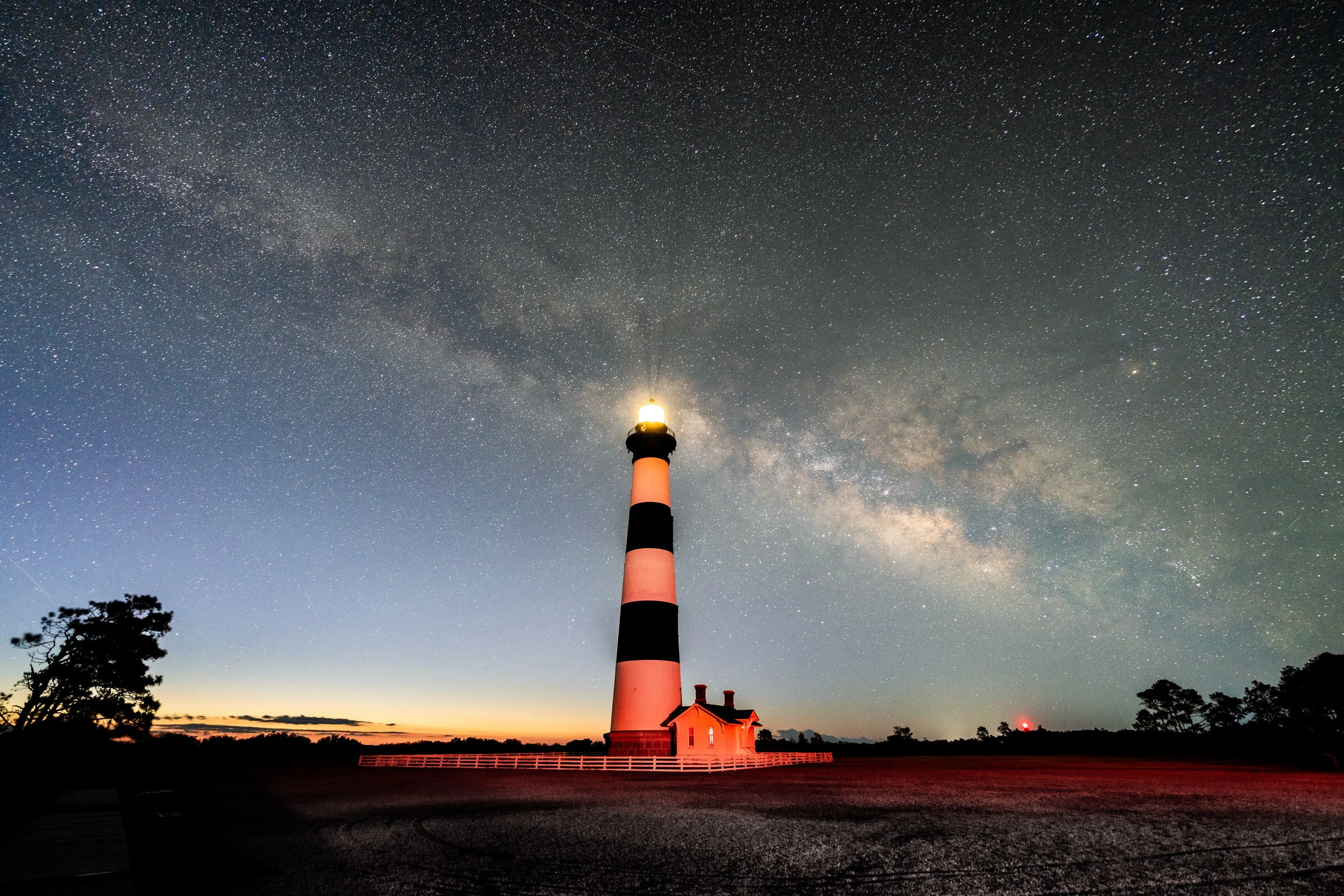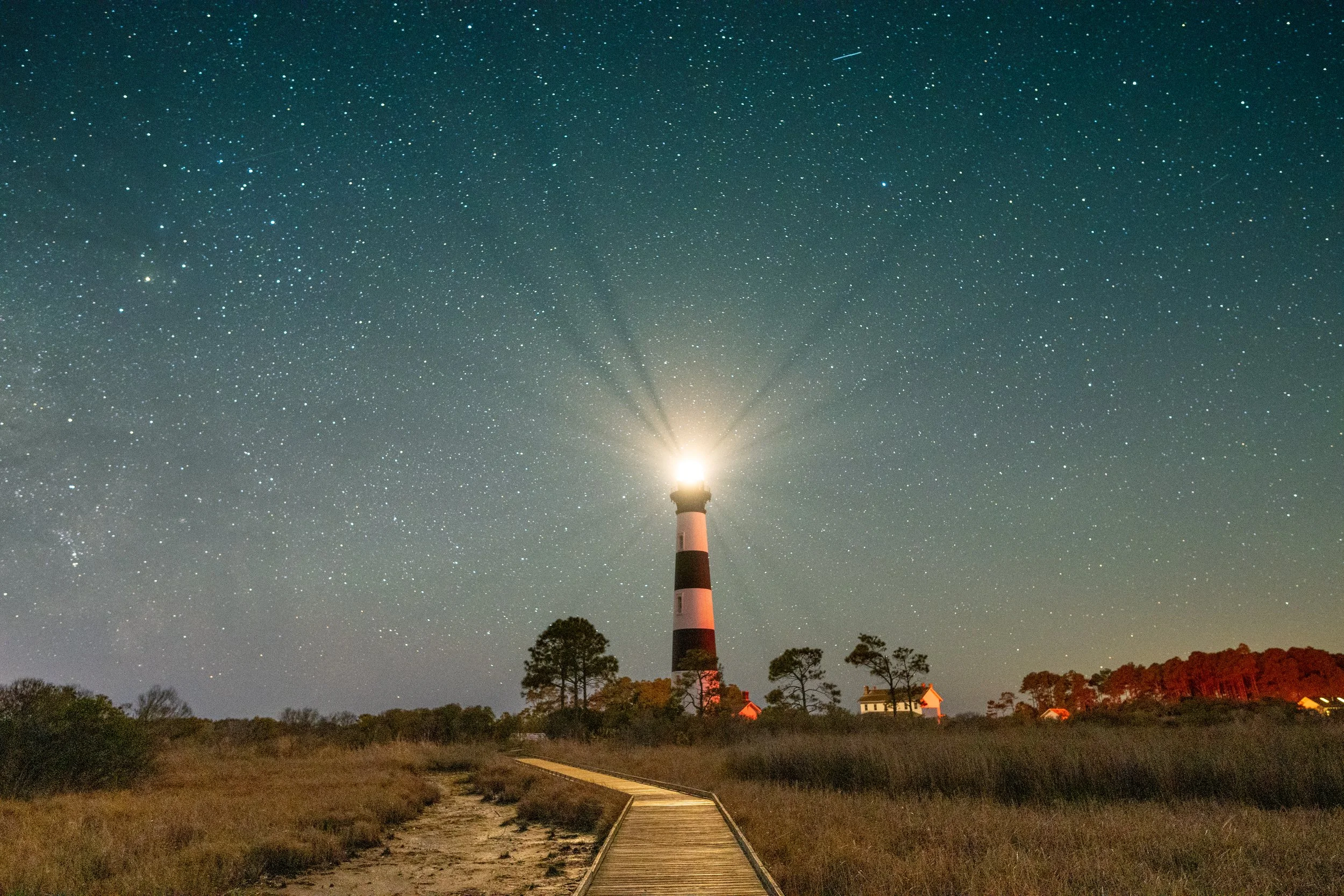Lighting up the Heavens
The new moon in late February marked the beginning of the Milky Way season for photographers and stargazers because the core of our galaxy becomes visible to us in the northern hemisphere. There are perhaps no better places in the Carolinas with a better view of the star filled skies than the North Carolina Outer Banks. And probably no better view than seeing the Milky Way stretch across the sky above the iconic Bodie Island Lighthouse.
North Carolina’s coastal waters are notorious for shipwrecks caused by shoaling which shifts with time and storms that periodically slam into the coast. The treacherous waters off of Cape Hatteras have seen so many shipwrecks it’s come to be known as the Graveyard of the Atlantic. From Corolla down to Southpoint and Bald Head Island, there are 7 lighthouses and most of them have served as navigational aides for well over one hundred years. Of the seven, the Bodie Island Lighthouse is by far my favorite.
What I love about this site is that it’s petty remote and isolated, especially during the months I prefer to visit. My first time to the site for photography was in February 2024. I arrived shortly after midnight and stayed until sunrise and I had the place entirely to myself. Also, being as remote as it is with very little light pollution, during a clear new moon night, the skies are full of stars. Perfect for photography.
How and when to photograph the Milky Way here…
The most dramatic photo opportunities of the Milky Way at the Bodie Island Lighthouse are around the new moon in February and March. Especially during March, it’s possible to capture the arc of the Milky Way. This is best done by merging several individual shots into a panoramic shot using Lightroom, or some other image editing app. One consideration to mention is the Lighthouse light pattern. The light blinks in a pattern, it doesn’t rotate like traditional lighthouse lamps. The pattern is something like 20 seconds OFF the 2.5 seconds ON then 2.5 seconds OFF then ON again for 2.5 seconds. Then repeat. It’s best to time the camera exposure time so that it only captures one of those 2.5 second lamp on periods.
The below steps should be helpful in capturing the image you want.
Notes:
These steps apply to single exposure, untracked (no star tracker used) photos. Milky Way photos require longer exposures, anywhere between 5-20 seconds is common. So a tripod is essential.
In late winter and spring, the Milky Way is visible in the southeastern sky, with the core near the horizon and the visible bands arcing up and to the left.
Use a wide angle lens, 20mm or wider.
Use a fast lens, F2.8 or wider (lower). An F1.4 will make some things a lot easier when doing night sky photography.
Avoid star streaks. Divide the focal length of the lens into 500 and don’t exceed that number when setting the shutter time.
Steps:
Set the camera mode to manual and autofocus to manual. You may be able to select manual focus using a switch on the lens itself. Set shutter time to 10-15 seconds. Open the F-Stop all the way open (lowest number). Set ISO to 3200. This just a starting place.
Point the lens at the brightest star in the sky and slowly focus the lens. Perfect focus will be at around the infinity mark.
Tip - Perfect focus is when the star becomes a pinpoint. Usually, if you’re slowly approaching perfect focus, you see the dimmer stars suddenly become visible in the viewfinder or live view. Look also for those dimmer stars appearing to know you’re focused.
Use the camera’s timer or a remote shutter button to avoid camera shake at the start of the shot.
Once focus is achieved, be careful not to bump the focus ring. Reorient the camera so that it’s pointing at the Milky Way and take a shot.
Evaluate the image and adjust exposure settings as needed. It’s best to take a lot of shots at different exposures, I’ve found that exposure levels that looked good when reviewing on my camera, on-site in a very dark environment, were a little too underexposed when reviewing on my Mac with Lightroom. So be sure to get some photos with more exposure than you think you need, just in case.
Whether you visit for photography or just for a night under a magnificently starry sky, the Bodie Island Lighthouse is a cool place to visit and spend a few hours.
Check out the National Park Service page for more on the history of this site and the area.
Happy travels!


